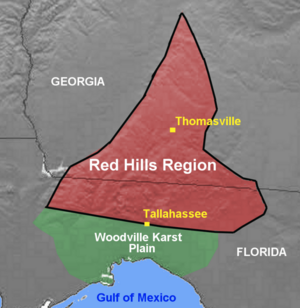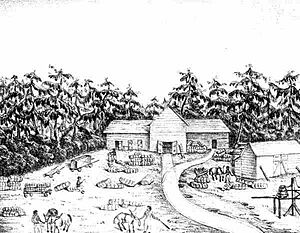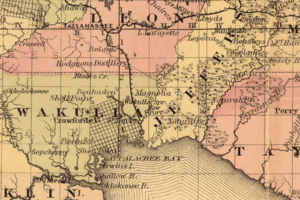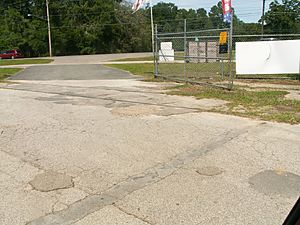Tallahassee Railroad facts for kids
| Overview | |
|---|---|
| Locale | Northern Florida |
| Dates of operation | 1836–1983 |
| Successor | Seaboard Air Line Railroad Seaboard Coast Line Railroad |
| Technical | |
| Previous gauge | 5 ft (1,524 mm) |
The Tallahassee Railroad was one of the very first train lines in Florida. It started running trains in 1836 or 1837. For over 20 years, instead of steam engines, mules pulled the trains! This railroad was super important for moving cotton from Tallahassee, Florida to ports on the St. Marks River.
Contents
How the Railroad Started
Tallahassee was in "Middle Florida," a busy and rich part of the Territory of Florida in the 1830s. This area, along with parts of Georgia, was known as the "Red Hills Region." Many farms here grew lots of cotton and tobacco.
Getting cotton to ships was hard. Farmers brought cotton bales to Tallahassee. From there, wagons had to pull them through deep sand to ports on the St. Marks River. This was a tough journey!
To make things easier, the government of Florida allowed a company called the Leon Rail-Way Company to build a railroad in 1831. But that company didn't get started. Then, another company, the Leon Railroad Company, also failed to raise enough money.
Finally, the Tallahassee Railroad Company was created in 1834. Richard K. Call, a plantation owner, became its leader. The government gave the company a huge amount of land, about 500,000 acres, to help build the railroad. They also got permission from the U.S. Congress to build tracks across government land.
Building the Tracks
We know a lot about how the Tallahassee Railroad was built thanks to a German expert named Franz Anton von Gerstner. He visited Florida in 1839 to study railroads in the United States.
Construction began in 1834 in Tallahassee. The tracks reached St. Marks, about 22 miles away, by 1836 or 1837. By 1839, the railroad was extended another 2 miles south to Port Leon, Florida. They even built a drawbridge over the St. Marks River to get there!
The tracks were made of "strap rail." This meant 8-foot-long wooden timbers had a thin, half-inch-thick iron strap on top. These were laid on wooden ties, spaced about 6 to 7 feet apart. The distance between the rails was 5 feet.
Most of the route was flat and forested. But the ground was often wet, and rain would wash away the sand under the tracks. This made the tracks uneven and hard to maintain. One traveler in 1855 even heard that the rails were first laid directly on the sand without any ties!
A French scientist, Francis de Laporte de Castelnau, visited in 1837-1838. He said the railroad was "very useful" because of the sandy ground. But he also called it "the very worst that has yet been built in the entire world." He said it was so poorly built that steam locomotives couldn't even run on it!
Port Leon: A Town That Disappeared
The first end point for the railroad was St. Marks. But the railroad company wanted more land for its facilities. So, they decided to build a new town called Port Leon. It was a little closer to the mouth of the river and on land the company owned.
Starting in 1838, the railroad company sold land lots in Port Leon. People from a nearby town called Magnolia, Florida moved to Port Leon. The railroad reached Port Leon in 1839. The town quickly grew to about 450 people and became an official town in 1841.
However, disaster struck. In 1841, yellow fever hit Port Leon, killing 139 people. Then, in September 1843, a huge hurricane hit. A storm surge, like a giant wave, rose 7 to 10 feet high. Only one person died, but every building in Port Leon was destroyed or badly damaged. The bridge across the St. Marks River was even carried away!
Many people moved to a new town called Newport. The railroad quickly fixed its line back to St. Marks, making it the main shipping spot again. Port Leon then slowly faded away.
How the Trains Ran
For many years, horses or mules pulled the trains. The company bought two steam locomotives, but they couldn't use them because the tracks were so bad!
By 1839, the railroad owned:
- Two unused steam locomotives
- Three passenger cars (one could only hold eight people!)
- 45 freight cars
- 35 horses and mules
- 23 enslaved people (who did most of the work)
- A sawmill
- 4,000 acres of woodlands
- A 1,000-acre farm to grow food for the animals
- The town of Port Leon itself
A single passenger car, pulled by two horses, ran daily in each direction. Horses were swapped halfway. A one-way trip took two and a half hours, going about 9 miles per hour. A ticket cost $1.50. In 1838, about 4,000 passengers rode the train.
Freight trains, with five to eight cars, also ran once a day. Six horses or mules pulled them at a slow 2.5 miles per hour. Most of the freight was cotton. In 1838, about 14,000 bales of cotton were moved. Each bale weighed 400 to 500 pounds!
The railroad's condition stayed poor for almost 20 years. A traveler in 1855 complained about his trip. He saw missing rails and ties. The iron straps on the rails were sometimes loose and curled up. At one point, a forest fire had burned the ties for 2 miles, but the train still went over it! The passenger train was delayed because a freight train had gone off the tracks. Passengers even had to help put the freight cars back on! Delays like this happened almost every day.
New Owners and Improvements
In 1855, Richard Keith Call sold his part of the Tallahassee Railroad to the Pensacola and Georgia Railroad. The next year, the entire line was rebuilt! They replaced the old wooden rails with strong iron ones. They also brought in two new steam locomotives.
By 1857, the president of the Pensacola and Georgia Railroad said the Tallahassee Railroad was "one of the best paying roads in the country." This means it was making a lot of money!
The Battle of Natural Bridge
During the American Civil War, in March 1865, the Union Army tried to attack the area around St. Marks. They wanted to cut off Florida from the rest of the Confederacy. Their plan was to burn bridges and destroy the Tallahassee Railroad.
Union soldiers landed near St. Marks. They marched towards Newport, but found the bridge over the St. Marks River burned. So, they decided to cross the river at a "natural bridge," where the river goes underground for a short distance.
News of the attack reached Tallahassee quickly. Confederate troops, including students from the West Florida Seminary, rushed to defend the area. They traveled down the Tallahassee Railroad to get closer to the natural bridge.
On March 6, the Union forces reached the natural bridge, but Confederate troops were already there, ready to fight. The Confederates successfully defended the crossing in the Battle of Natural Bridge. The Union troops had to retreat.
Joining Bigger Railroads
Over the years, the Tallahassee Railroad became part of bigger and bigger railroad companies.
- In 1867, it was bought and merged into a new company also called the Tallahassee Railroad.
- This company then joined the Jacksonville, Pensacola and Mobile Railroad in 1869.
- Later, it became part of the Florida Central and Western Railroad in 1882.
- Then, it joined the Florida Railway and Navigation Company in 1884.
- It was renamed the Florida Central and Peninsular Railroad in 1888.
- Finally, the Seaboard Air Line Railway leased it in 1900 and bought it in 1903.
Under the Seaboard Air Line and its later companies, this line was known as the Wakulla Subdivision.
The End of the Line
The Seaboard Air Line Railway stopped using the last 2 miles of the line into St. Marks in 1932. They got permission to use it again in 1939. The St. Marks branch continued to be used through the 1960s.
But in 1983, the Seaboard Coast Line Railroad (the company that took over from Seaboard Air Line) officially stopped using the line. The State of Florida bought the old railroad path in 1984. Today, 16 miles of that path have become the Tallahassee-St. Marks Historic Railroad State Trail. It's a popular trail for walking, running, and biking!
Historic Stations
| Milepost | City/Location | Station | Connections and notes |
|---|---|---|---|
| SPA 799.3 | Tallahassee | Tallahassee | junction with:
|
| SPA 802.2 | St. Marks Junction | ||
| SPA 803.3 | Belair | ||
| SPA 805.6 | Lutterloh | ||
| SPA 808.2 | Rhodes | ||
| SPA 808.8 | Woodville | Woodville | |
| SPA 809.4 | Moody | ||
| SPA 811.3 | Burnt Mill | ||
| SPA 812.1 | Vereen | ||
| SPA 814.5 | Wakulla | ||
| SPA 815.7 | Burns | ||
| SPA 817.5 | Newport | ||
| SPA 820.2 | St. Marks | St. Marks |





